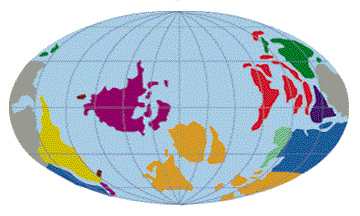This graph shows that the amount of oxygen has increased as the Earth has aged.
Click on image for full size
Kentucky Coal Education Web Site.
The slow build up of Oxygen in the Earth's Atmosphere
It took a long time for oxygen to build up in Earth's atmosphere. At
first the atmosphere was made of H,
then with volcanic eruptions the atmosphere was made of CO
2, SO
2, ammonia, and other gases, then the atmosphere was made mostly of nitrogen. Today the atmosphere is 80% nitrogen (N
2) and 20% oxygen (O
2).
The table at the left shows just how slowly it took for oxygen to accumulate in the atmosphere. 3.5 BYA there was only 0.01% oxygen in the atmosphere. 2.5 BYA there was only 0.1% oxygen in the atmosphere. Imagine how hard it would be to breathe in such an environment. At the top of Mt. Everest (where it is very hard to breathe!) there is enough oxygen to be equivalent to 18% levels.
The formation of life on Earth played a very large role in the build up of oxygen in the environment. As early as 3.5 BYA, photosynthetic bacteria began to produce oxygen as a waste product of their activity. That oxygen reacted with iron in the ocean to make iron ore. Later, after the iron in the ocean was gone, and the making of iron ore was finished, about 2.5 BYA, enough oxygen accumulated for respiration (for animals which breathe oxygen) to begin in simple organisms, organisms like protozoans, amoeba, etc.; single-celled beings with a nucleus. In sophisticated cells with a nucleus (eucaryotic cells), not only respiration, but even photosynthesis is more efficient, so the production of oxygen accelerated. Oxygen continued to build at an accelerating pace until 1% oxygen levels were obtained. The more oxygen accumulated in the atmosphere, the larger became the protective ozone layer (made of O3 and formed from oxygen in the atmosphere). Ozone helped protect developing life from the harmful effects of the Sun's ultraviolet radiation. Then other life forms such as sponges, worms, and other organisms came to be.
Once oxygen levels of 1% were achieved, and an ozone layer developed, a seeming explosion in the development of different kinds of life forms occurred. The Earth had entered what is known as the Cambrian age.
You might also be interested in:

There are quite a few theories about the origin of the heavy molecules which comprise the Earths atmosphere today. Since all the planets including Earth were still forming during the Suns T-Tauri phase,
...more
The first beings were probably much like coacervates. As a group, these bacteria are called heterotrophic anaerobes. Because there was virtually no oxygen in the atmosphere at this time, these bacteria
...more
Eventually, as with the development of photosynthesis along sulfur and methane pathways, where sulfur and methane products are produced, photosynthesis along the oxygen pathway, where oxygen is produced,
...more
We all know that salt is a big part of the ocean water today. Two things help scientists figure out what chemicals may have been part of the Earth's early oceans. Igneous rocks are made of iron, aluminum,
...more
The Archean is the name of the age which began with the forming Earth. The duration of the Archean, 2.8 billion years, is more than half the expected age of the Earth. We don't know much about this period,
...more
This period of time in Earth's history is a period when dinosaurs roamed the Earth. This period lasted 37 Million years. During this time, the continents we know today were combined into a giant continent
...more
An ocean began to form on Earth as soon as the temperature fell from very hot, to about room temperature, a temperature where liquid water is stable. According to the Goldilocks theory, Earth is at just
...more
Why did the dinosaurs go extinct? No one knows for sure, and scientists have come up with a number of theories to explain why the dinosaurs suddenly died out about 65 million years ago. The most prominent
...more














